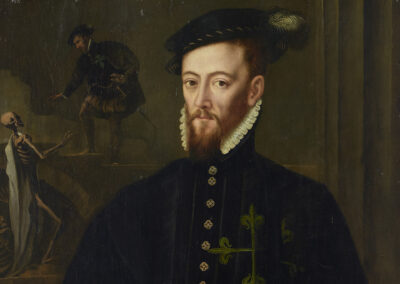Some elements of the clothing that appear in this portrait and in the portrait of the lady with whom it is paired - the high lettuce brushing the ears, the flat cap adorned with a feather in the case of the marquis, the headdress in the case of the marquess, the headdress in the case of the marquise - have led us to date both portraits to the end of the 1550s, the headdress in the case of the Marquise - have led us to date both to the late 1550s, to identify the portraits with the second Marquises of Las Navas, Don Pedro Dávila y Córdoba and Doña Jerónima Enríquez de Guzmán, and to propose their wedding in 1559 as the probable occasion for their execution. Pedro Dávila had been educated in humanist culture by his father, Pedro Dávila y Zúñiga, butler to Prince Philip's House of Burgundy, and with him he was summoned to Toledo in February 1560 to attend the lavish entry of Isabella of Valois, the third wife of Philip II. Considered a discreet negotiator, the king entrusted him with two extraordinary embassies to Rome, where he died in the second of them in 1574.
Both portraits were added to the Medinaceli collection in 1789, due to the marriage of the 3rd Duchess of Santisteban - to which the house of Las Navas had been added in 1645 - to the 13th Duke of Medinaceli. The inventory of the Dukes of Santisteban of 1750, entitled "Reason for the linked paintings. AddThe Commission's assessment of Franc's predecessors is based on theisco de Benavides] describes the painting as ".A panel portrait of the Marquis of lthe Navas who spoke to the dead"in reference to the scene in the background of the upper left-hand corner. This description, repeated in successive inventories, would correspond to the third marquis, Pedro Esteban Dávila (1560-1623), whose youthful excesses led to his imprisonment by royal order and were first recorded in the Second account of the life of the squire Marcos de Obregón by Vicente Espinel, published in 1618, and later in the comedy by Lope de Vega, The Marquis of Las NavasThe manuscript version of which is signed and dated by the author on 22 April 1624, a year after the death of the marquis to whom he had been secretary in his youth, before 1588. One of Pedro Estebán Davila's youthful dalliances in the company of his younger brother, the 1st Marquis of Povar, gave rise to an episode that Espinel claims to have overheard them both. The latter recounts that one night the marquis mortally wounded a man who, during his agony, appointed him his executor, with the intention that, as compensation, he would put "...".a daughter of his in a state". The dead man, "with God's dispensationappeared to the Marquis on several occasions - "...".that the Lord of heaven and earth is in the habit of giving licence for such matters, for things so particular that they are important for the salvation of his soul."until he complied with the request. From the clear differences between the profile lines of the right and left shoulders, as well as the different brushstrokes and style with which the scene is executed, it can be inferred that the background was repainted to incorporate it later in its literary dissemination, confusing the second marquis with the third, as the latter, born in 1560, did not marry -with Juana Manrique- until 1588, a date that seems too late for this portrait and its companion.
Both panels have traditionally been attributed to Antonio Moro, who may have painted them in Toledo in the late 1550s. However, Maria Kusche rejected this attribution, proposing Roland de Mois as their author. She put forward two arguments: "The has the typical flat hands as painted by the artist and the narrow asymmetrical face as the artist usually conceives it." y "The small scene, perfectly integrated into the composition, fits completely into the very fluid and loose style that Moys demonstrates in the scenes of his religious works.". The author, however, does not dispute the dating of the work to 1559, erroneously attributing the anecdote to the 2nd Marquis and bringing it forward by more than two decades: on this point, as we have said, Vicente Espinel makes it very clear that this event was told of himself by the Marquis de las Navas who "...".agora vive"The painting is dated 1618, the year it was published, and his brother, the 1st Marquis of Povar, and is dated to the time of their youth, i.e. the 1580s. Lucía Varela (2000) pointed out the difficulty of Mois painting the Marquises of Las Navas, as there is no record of the painter leaving Aragon, where he arrived accompanying the Count of Ribagorza on his return from Brussels in 1559. The presumed earlier stay at court, proposed by Kusche, has no support other than the attribution, rejected by Leticia Ruiz (2007), of the portraits of Juana of Austria of 1557 (Kunsthistorisches Museum in Vienna and Bilbao Fine Arts Museum), traditionally considered to be autograph by Sánchez Coello. With no documented stay at court and without the possibility that the same artist painted the portrait and the literary scene in the background around 1559, the new attribution of this canvas has no basis other than the stylistic appreciation of the hands and face by comparison with other works of highly disputed attribution to the portraitist of the house of Villahermosa, This is too weak a basis to deprive these portraits of the traditional authorship that their quality deserves, and we therefore believe it more reasonable to attribute them, if not to Moro's hand, at least to his closest circle, perhaps, as Lucía Varela suggested, under the direction of the master.



